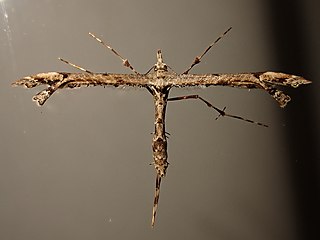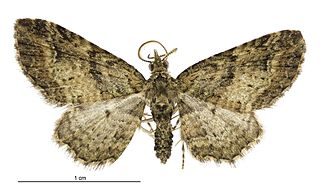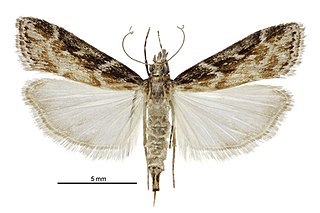
Xanadoses is a monotypic moth genus in the family Cecidosidae. It contains a single species, Xanadoses nielseni, which is endemic to New Zealand. X. nielseni is also known by the common name Kamahi bark scribbler. The larval host of this species is Weinmannia racemosa.

Ochetarcha is a genus of moths belonging to the subfamily Tortricinae of the family Tortricidae. It contains only one described species, Ochetarcha miraculosa, also known as the ponga stem borer, which is found in New Zealand.
Apoctena is a genus of moths belonging to family Tortricidae.

Planotortrix excessana, the greenheaded leafroller, is a moth of the family Tortricidae. It is native to New Zealand and is an introduced species in Hawaii. It is extremely variable in appearance and feeds on many native and introduced species. It is regarded as a pest of some agricultural and forestry crops.

Ischalis variabilis, also known as oblique-waved fern looper, is a species of moth in the family Geometridae first described by William Warren in 1895. It is endemic to New Zealand, where it is widespread in the North and South islands.

Amblyptilia repletalis is a moth of the family Pterophoridae. It is endemic to New Zealand and can be found throughout the country from North Cape to Bluff. The species inhabits a variety of habitats including native forest clearings, shrubland, coastal dunes and gardens. Larvae feed on the seed heads of Plantago plant species. Adults are on the wing all year round and are attracted to light.

Pasiphila charybdis is a species of moth in the family Geometridae. It is endemic to New Zealand.

Scoparia molifera, also known as the leather-leaf Scoparia, is a species of moth of the family Crambidae. This species was first described by Edward Meyrick in 1926 and is endemic to New Zealand. It can be found in the North and South Islands. The larvae of this species make silk tunnels from which they mine the leaves of their host, the leather-leaf fern Pyrrosia eleagnifolia. Adult moths are on wing from December to February and are attracted to light.

Hierodoris atychioides is a moth of the family Oecophoridae. It was described by Arthur Gardiner Butler in 1877. The female holotype specimen held at the Natural History Museum, London. This species is endemic to New Zealand, and can be found in the North, South and Stewart Islands. The larvae form webs of silk attached to frass and leaves on their hosts in which they shelter, often in the company of other larvae in their species. Their feeding habits have not been observed in detail but Hoare hypothesises the larvae may feed on dead or dying leaves. The larvae feed on a wide range of trees and shrubs, including Dacrydium cupressinum, Prumnopitys taxifolia, Dacrycarpus dacrydioides, Libocedrus bidwillii, Cupressus macrocarpa, Leptospermum scoparium, Kunzea ericoides, Ozothamnus leptophyllus, Abies, Picea, Pinus and Thuja species. Although they are regarded as a pest of exotic forests in New Zealand, the economic damage the larvae cause is minimal and they tend to be controlled only by their natural enemies. Larval enemies include the parasitic flies Trigonospila brevifacies and Pales funesta as well as parasitic wasps including Xanthopimpla rhopaloceros. The adult moths are day flying and are most common during the months of December and January. This species is variable in appearance as larvae, pupa and as adults, and it has been hypothesised that it is in the process of speciation.

Ctenopseustis fraterna, the brownheaded leafroller or the rusty ponga leaf-tyer, is a species of moth of the family Tortricidae. It is found in New Zealand, where it has been recorded from the North Island only. The common name is also used for the related species Ctenopseustis herana and Ctenopseustis obliquana.

Ctenopseustis filicis, also known as ginger ponga leaf-tyer, is a species of moth of the family Tortricidae. It is endemic to New Zealand and is found in the South and Stewart Islands.

Apoctena clarkei, also known as the umbrella fern bell moth, is a species of moth of the family Tortricidae. It is found in New Zealand, where it is only found on the North Island.

Apoctena fastigata is a species of moth in the family Tortricidae. It is found in New Zealand, where it is only found on the South Island.

Apoctena orthocopa, also known as striped ponga leaf-tyer, is a species of moth of the family Tortricidae. It is endemic to New Zealand, where it is found only on the North Island.

Apoctena persecta is a species of moth of the family Tortricidae. It is found in New Zealand, where it is found only on the South Island.

Apoctena taipana is a species of moth of the family Tortricidae. It is endemic to New Zealand and has been observed in both the North and South Islands. The larvae created a silken tube in which they hide and also use to travel from leaf to leaf. They tunnel into the leaves of their host. Larvae can be found from June to August. Adult moths can be seen on the wing from October to January.

Ecclitica torogramma, also known as the ponga ugly nestmaker, is a species of moth of the family Tortricidae. It is endemic to New Zealand.

Pyrgotis plinthoglypta is a species of moth of the family Tortricidae. It is endemic to New Zealand and is found throughout the whole country. The preferred habitat of this species is native forest. The larvae of this species feeds on rimu leaves from under a silken web. It pupates in loose cocoons amongst rimu foliage. Adults are on the wing from October to May and are night flying. They are attracted to light and can be collected by beating their host tree. The adult insect resembles a small dried fragment of rimu foliage when at rest.

Pyrgotis transfixa is a species of moth of the family Tortricidae. It is endemic to New Zealand. It is classified as "At Risk, Naturally Uncommon" by the Department of Conservation.

Thylacosceles acridomima, also known as the pūniu spore-eater or the micro-featherfoot, is a moth of the family Stathmopodidae. This species is endemic to New Zealand. It was first described by Edward Meyrick in 1889.



















